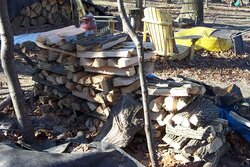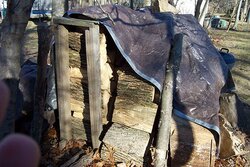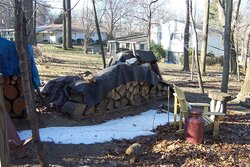Here we are three days into the new year. I just wheeled two full barrows of fuel closer to my back door, and this pee wee pile is what's left of my "split and ready to burn". Well, I knew I wasn't going to make it thru the winter on what I had in summer and early fall. So as I collected fresh fuel closer to the burning season, I tried a new idea. (New to me. ) I took just enough time to split 80-90% of my remaining into thirds and quarters. Then stacked and covered it. So, for all those who have limited access to a splitter, or limited time for these pursuits, if you haven't already tried this, maybe it's worth considering. Rather than spend all your time splitting as much as you can down to burning size, take four or five hours and reduce as many of your whole rounds down to quarters as you can. This way it seasons somewhat while you use your existing fuel, and you don't have to break it out of frozen oblivion and handle monstrously heavy pieces in the cold cold. Sometime in the very near future I will be tackling these for fuel to last thru till spring. And seeing as my shoulder is really hurting about now, I'm very glad I wrassled with those 200+ lb rounds four months ago.
As it says in my vintage Vermont Castings operations manual "There can be over a ton of water in a cord of green wood, or more than 250 gallons. Wood grows outward from the center in a series of concentric cylinders or rings. When wood dries, water moves in the spaces between the cylinders ten times faster than it does across or through the cylinder walls. This means that unsplit wood dries only through the ends of the logs. Large and long logs should be split to expose the spaces between the rings in order to aid the drying process."
As it says in my vintage Vermont Castings operations manual "There can be over a ton of water in a cord of green wood, or more than 250 gallons. Wood grows outward from the center in a series of concentric cylinders or rings. When wood dries, water moves in the spaces between the cylinders ten times faster than it does across or through the cylinder walls. This means that unsplit wood dries only through the ends of the logs. Large and long logs should be split to expose the spaces between the rings in order to aid the drying process."





